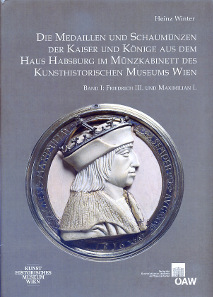by Ursula Kampmann
translated by honeycutshome
October 23, 2014 – One of the most beautiful areas of numismatics are the splendid coins issued by Maximilian I at the turn of the late Middle Ages to the Renaissance. Anyone who would like to dive into this subject is recommended to read two new publications. One is the first volume of the catalog of the collections of medals and schaumünzen housed by the Kunsthistorisches Museum Vienna, which first and foremost contains the coinage of Maximilian I. Like a historical addition to this seems the exhibition catalog published on the occasion of the big exhibition on Maximilian in Mannheim which comprises two important articles on numismatics. The one responsible in both cases is Heinz Winter, great expert of Hapsburg numismatics.
Heinz Winter, Die Medaillen und Schaumünzen der Kaiser und Könige aus dem Haus Habsburg im Münzbakinett des Kunsthistorischen Museums Wien. Bd. 1: Friedrich III. und Maximilian I. (Katalog der Medaillensammlung Band 2). Wien, Verlag der Österreichischen Akademie der Wissenschaften, 2013. 30,3 x 21,7 cm, 375 p., 79 plates in full color. Hardcover. ISBN: 978-3-7001-7502-5. 49,90 Euro.
Let us begin with the ambitious project, i.e. the publication of the entire stock of schaumünzen and medals of both the kings and the emperors of the House of Hapsburg in the possession of the Kunsthistorisches Museum Vienna. Ambitious because the Vienna Coin Cabinet includes the former Hapsburg house collection with the first object dating back to the years between 1607 and 1611. Hence, the collections catalog is highly likely to become weighty, as is already indicated by its initial volume. 79 plates illustrate 119 objects, with numbers according to type, in superb photographs. And this first volume only deals with the early phase of medallic art in Central Europe.
It starts with hereditary medals and in this context also refers to the famous Alchemical Medallion which is so big that not even such a magnificent illustrated book can show it in its actual size. The first contemporary piece is one of Archduke Sigismund of Tyrol, made in 1483 within the context of the planned reforms of the Hall Mint in Tyrol. Rudolf I and Frederick III are next in line. Most of the coins bearing their portraits were made posthumously. Under Maximilian, in contrast, contemporary medallic art virtually exploded. The former coin cabinet of the Hapsburg family is a unique testimony to this. Browsing through the plates is eye candy. Additionally, it gives you intellectual pleasure when you read the thorough object descriptions that also include accurate interpretations of the coats of arms.
A comprehensive numismatic commentary adds to the text, and of course the history of the collection is commented on as well. It is to be hoped that this first volume will soon be followed by subsequent volumes. It is a real asset to every library.
Sabine Haag e.a. (Ed.), Kaiser Maximilian I. Der letzte Ritter und das höfische Turnier. Regensburg, Schnell & Steiner, 2014. 28,6 x 24,7 cm, 245 p., fig. in full color. Hardcover. ISBN: 978-3-7954-2842-6. 34,95 Euro.
Something similar can be said about the exhibition catalog of the Reiss-Engelhorn-Museen about ‘Emperor Maximilian – The Last Knight and the Courtly Tournament’. The text is divided into three parts: his multi-faceted personality, the emperor and the courtly tournament as well as the emperor’s afterlife. Numismatics and economic history being closely intertwined becomes apparent when skimming the first chapter that deals with the ‘Policy of Emperor Maximilian I’. Topics addressed include wealth, silver mines, promises to give money, pledges and debts. It becomes evident that finances played a major part in the life of Maximilian. One article, therefore, is devoted to the Fugger family, to Tyrol and the silver from Schwaz. It outlines the economic background against which Maximilian developed his policy. Some wonderful coins are illustrated here, from the first guldiner to the simple batzen from St. Veit. Fortunately, they are shown according to their real size and come with correct numismatic descriptions. (We expected nothing else, Heinz Winter being the author!)
It is telling that the catalog is concluded by an article on the schaumünzen of Maximilian I made in the Hall Mint in Tyrol. This is the essence, as it were, of the magnificent 1st volume of the KHM collections catalog.
So the choice is left to the reader if he prefers the work of reference and thus goes for the collections catalog or if he deems the historical background more important and hence opts for the catalog with the compiled essays. We can wholeheartedly recommend both books.





